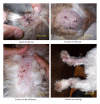A water-damaged home and health of occupants: a case study
- PMID: 22220187
- PMCID: PMC3246741
- DOI: 10.1155/2012/312836
A water-damaged home and health of occupants: a case study
Abstract
A family of five and pet dog who rented a water-damaged home and developed multiple health problems. The home was analyzed for species of mold and bacteria. The diagnostics included MRI for chronic sinusitis with ENT and sinus surgery, and neurological testing for neurocognitive deficits. Bulk samples from the home, tissue from the sinuses, urine, nasal secretions, placenta, umbilical cord, and breast milk were tested for the presence of trichothecenes, aflatoxins, and Ochratoxin A. The family had the following diagnosed conditions: chronic sinusitis, neurological deficits, coughing with wheeze, nose bleeds, and fatigue among other symptoms. An infant was born with a total body flare, developed multiple Cafe-au-Lait pigmented skin spots and diagnoses with NF1 at age 2. The mycotoxins were detected in bulk samples, urine and nasal secretions, breast milk, placenta, and umbilical cord. Pseudomonas aueroginosa, Acinetobacter, Penicillium, and Aspergillus fumigatus were cultured from nasal secretions (father and daughter). RT-PCR revealed A. fumigatus DNA in sinus tissues of the daughter. The dog had 72 skin lesions (sebaceous glands and lipomas) from which trichothecenes and ochratoxin A. were detected. The health of the family is discussed in relation to the most recent published literature regarding microbial contamination and toxic by-products present in water-damaged buildings.
Figures


Similar articles
-
Chronic illness associated with mold and mycotoxins: is naso-sinus fungal biofilm the culprit?Toxins (Basel). 2013 Dec 24;6(1):66-80. doi: 10.3390/toxins6010066. Toxins (Basel). 2013. PMID: 24368325 Free PMC article. Review.
-
Mycotoxins in crude building materials from water-damaged buildings.Appl Environ Microbiol. 2000 May;66(5):1899-904. doi: 10.1128/AEM.66.5.1899-1904.2000. Appl Environ Microbiol. 2000. PMID: 10788357 Free PMC article.
-
Detection of mycotoxins in patients with chronic fatigue syndrome.Toxins (Basel). 2013 Apr 11;5(4):605-17. doi: 10.3390/toxins5040605. Toxins (Basel). 2013. PMID: 23580077 Free PMC article.
-
Fungal contamination and mycotoxin detection of powdered herbal drugs.Appl Environ Microbiol. 1978 Aug;36(2):252-6. doi: 10.1128/aem.36.2.252-256.1978. Appl Environ Microbiol. 1978. PMID: 697361 Free PMC article.
-
The biocontaminants and complexity of damp indoor spaces: more than what meets the eyes.Toxicol Ind Health. 2009 Oct-Nov;25(9-10):583-615. doi: 10.1177/0748233709348386. Epub 2009 Sep 30. Toxicol Ind Health. 2009. PMID: 19793773 Review.
Cited by
-
Chronic illness associated with mold and mycotoxins: is naso-sinus fungal biofilm the culprit?Toxins (Basel). 2013 Dec 24;6(1):66-80. doi: 10.3390/toxins6010066. Toxins (Basel). 2013. PMID: 24368325 Free PMC article. Review.
-
An Evolutionary-Based Framework for Analyzing Mold and Dampness-Associated Symptoms in DMHS.Front Immunol. 2017 Jan 9;7:672. doi: 10.3389/fimmu.2016.00672. eCollection 2016. Front Immunol. 2017. PMID: 28119688 Free PMC article.
-
The Putative Role of Viruses, Bacteria, and Chronic Fungal Biotoxin Exposure in the Genesis of Intractable Fatigue Accompanied by Cognitive and Physical Disability.Mol Neurobiol. 2016 May;53(4):2550-71. doi: 10.1007/s12035-015-9262-7. Epub 2015 Jun 17. Mol Neurobiol. 2016. PMID: 26081141 Review.
-
Advancing Global Health Surveillance of Mycotoxin Exposures using Minimally Invasive Sampling Techniques: A State-of-the-Science Review.Environ Sci Technol. 2024 Feb 27;58(8):3580-3594. doi: 10.1021/acs.est.3c04981. Epub 2024 Feb 14. Environ Sci Technol. 2024. PMID: 38354120 Free PMC article. Review.
-
A review of the diagnosis and treatment of Ochratoxin A inhalational exposure associated with human illness and kidney disease including focal segmental glomerulosclerosis.J Environ Public Health. 2012;2012:835059. doi: 10.1155/2012/835059. Epub 2011 Dec 29. J Environ Public Health. 2012. PMID: 22253638 Free PMC article. Review.
References
-
- Mudarri D, Fisk WJ. Public health and economic impact of dampness and mold. Indoor Air. 2007;17(3):226–235. - PubMed
-
- Park JH, Cox-Ganser JM. Mold exposure and respiratory health in damp indoor environments. Frontiers in Bioscience E. 2011;3:575–571. - PubMed
-
- Dennis DP. Chronic sinusitis: defective T-cells responding to superantigen treated by reduction of fungi in the nose and air. Archives of Environmental Health. 2004;58(7):433–441. - PubMed
Publication types
MeSH terms
Substances
LinkOut - more resources
Full Text Sources
Medical
Research Materials
Miscellaneous

